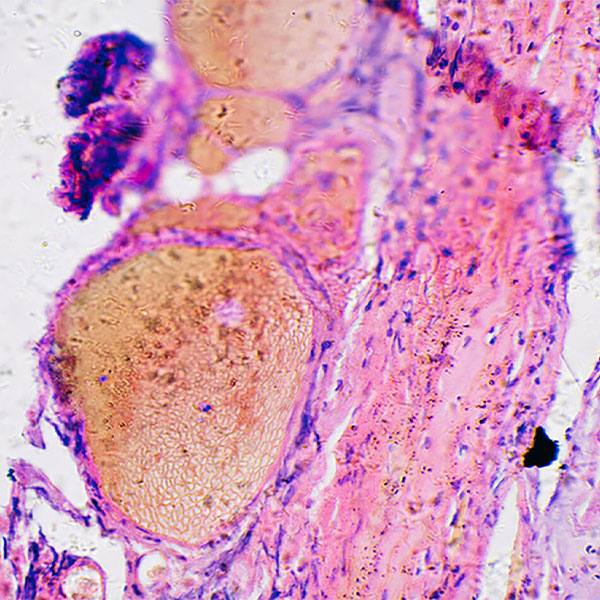-
Research
Lab-grown ‘mini brains’ help Mayo Clinic scientists shed light on therapeutic targets for opioid addiction

Unimaginable a decade ago, Mayo Clinic scientists have developed lab-grown miniature 3D brain models out of human cells to study opioid addiction and opioid treatment response. As a result, the team has discovered changes in specific brain cells of people diagnosed with opioid use disorder when compared to those without the addiction disease.
The new study, published in Molecular Psychiatry, helps clarify a potential therapeutic target for opioid addiction and adds to the knowledge of the path to addiction.
"The human brain is amazingly complex, and the way in which opioids affect the brain in addiction has remained unclear despite the soaring opioid-overdose death toll," says Ming-Fen Ho, Ph.D., a stem cell biologist in Mayo Clinic’s Departments of Psychiatry and Psychology and Molecular Pharmacology and Experimental Therapeutics. Dr. Ho is the lead author of the study.
"This new 'mini brain' technology gives us access to study complex human brain disorders in ways we never have before," says Dr. Ho, who began her career as a nurse and went on to acquire her Ph.D. in molecular genetics — a new way to continue her passion for helping patients. As part of her addiction research, Dr. Ho spent time listening to patients in the clinic to hear firsthand about their addiction experiences.
Opioids were linked to nearly 100,000 overdose deaths in the U.S. in 2021, according to the Centers for Disease Control (CDC), including prescription opioids that treat severe pain, such as oxycodone. Prescription opioids are associated with nearly 1 in 5 opioid overdose deaths, according to the CDC.
Millions of other people with an opioid drug addiction rely on treatments, such as the drug buprenorphine, to reduce cravings and withdrawal symptoms. But treatment adherence is challenging, which impairs efficacy.
"Given the extensive use of opioids and the global opioid epidemic, it is essential that we understand how opioids and drugs used to treat opioid use disorder change the function of brain cells at the single-cell level," Dr. Ho says.
Organoids provide a window into brain disorders

For the study, Dr. Ho and her team first created miniature 3D brain-like models, called organoids. The pea-sized 3D clusters of cells began as blood cells from patients diagnosed with opioid use disorder. The blood cells were placed in a culture dish and "reprogrammed" back into a stem-cell-like state, called induced pluripotent stem cells. These so-called master cells can be coaxed to develop into any cell in the body, including brain cells.
"The cells grow and assemble on their own to replicate parts of the brain — in this case, the prefrontal cortex," Dr. Ho says. "We chose the prefrontal cortex because previous preclinical and clinical studies have identified a key involvement of this brain region in addiction."
Next, the team studied the effects on the organoids of the two drugs — oxycodone and buprenorphine — and performed pathway analysis for each drug.
"We used single-cell sequencing technology to sequence the RNA in over 25,000 single cells in the organoids," Dr. Ho says. "And we compared them before and after drug exposure. We compared different cell types, and we also compared cells from healthy people to those with opioid addiction."

Dr. Ho and her team discovered biological pathways related to opioid addiction at the single-cell level. The results suggest a relationship between opioid addiction and inflammation, which is when the immune system in the brain is overactive.
"Our studies have implications for molecular mechanisms that will help us understand the effect of opioids in the brain, and a step toward the discovery of new therapeutic agents for the treatment and/or prevention of opioid addiction," Dr. Ho says. "An important next step for this research will involve testing those potential therapies for the treatment of opioid addiction using organoids generated from healthy people as well as people with opioid addiction."
This study was led by researchers within Mayo Clinic's Department of Molecular Pharmacology and Experimental Therapeutics in the Center for Individualized Medicine and Mayo Clinic's Department of Psychiatry and Psychology.
Acknowledgments
This work was supported in part by Mayo Clinic Center for Individualized Medicine, National Institutes of Health, and the Terrance and Bette Noble Foundation.
Learn more
Read more stories about advances in individualized medicine.
Register to get weekly updates from the Mayo Clinic Center for Individualized Medicine blog.
Join the conversation
For more information, visit Mayo Clinic Center for Individualized Medicine, or Twitter at @MayoClinicCIM.








